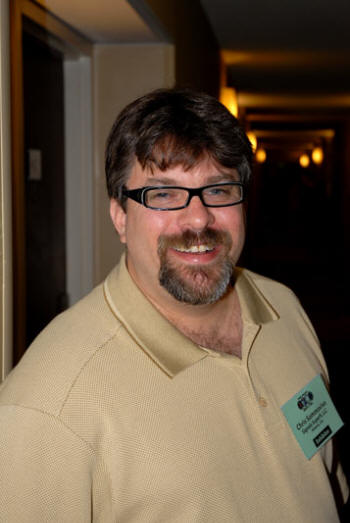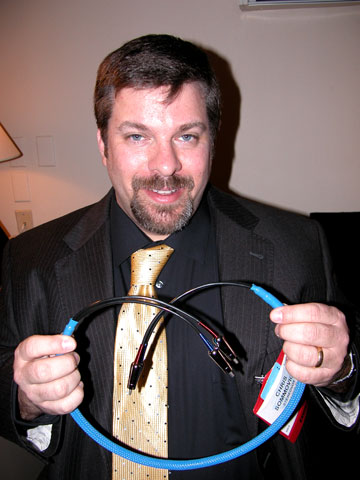You are reading the older HTML site
Positive Feedback ISSUE
july/august 2008

A Report from the Front: An Afternoon with the Guys
Max Dudious
[Photographs and image processing by Robinson]
On a recent Saturday afternoon in the end of May, I was called upon by Chris Sommovigo, the importer of German Physiks loudspeakers, to travel with him and David Berning (the designer and manufacturer of Berning amps, natch) to Falls Church, Virginia, for a meeting of a local audio club. The host was Jeff Fox, the owner of Command Performance AV, a retailer. There was some wine and beer, with cheese-and-crackers-type snacks offered, and during the course of the listening session (4:00 p.m. – 7:00 p.m.) members came and went with their favorite CDs, with about a dozen listeners in the room most of the time.

Chris Sommovigo, President of The Signal Collection, at the Rocky Mountain Audio Fest 2007 - where he won a PFO Audio Oasis! Award from Ye Olde Editor.
It was a very enlightening afternoon for me, being able to hear how the German Physiks PQS 202 Mk II speakers sounded in a pretty large and heavily "treated" room. (I am preparing my impressions for an upcoming full review here at PFO.) The speakers were driven by David Berning's Quadrature ZOTL (impedance matching, output transformer-less) amplifiers, a ZOTL type prototype Berning pre-amplifier (soon to be commercially available), and a Berning-tweaked (but not commercially available) CD player. The host, Jeff Fox, was appropriately gracious. His partner, "Digger," was very helpful and likeable. They and the members of the group were good company. I heard a lot of good music I wouldn't have otherwise heard, and I got to socialize in the company of some knowledgeable guys. I don't think anyone there knew I was a writer for Positive Feedback Online, except for Jeff and Chris Sommovigo. For me, the time was well spent. Interested audiophiles in the District, and the MD or VA suburbs, ought to check out Jeff Fox at http://www.commandav.com to see what he's up to lately, and to make an appointment to visit.
If I believed in signs and portents, I would have stayed the bleep home, because the local radio stations were warning us of possible tornadoes in the area. Well, I've lived in the Baltimore-Washington corridor nearly all my life, and I've heard such warnings and seen threatening clouds (clouds that hung around for days) before. I was cool. But when the hail stones started bouncing off the van, stones that are sometimes a precursor to very severe storms, when the wind kicked up and the rain came down in sheets, I wondered if I should have not been so dismissive about the tornado watch. But we arrived safely without water damage to the van, the equipment, or the passengers.

Chris Sommovigo at CES 2006 displaying one of his cable designs.
I turned to Chris and said, "Sommovigo, I don't think we're in Kansas any more." He barked his assent. When we ran the five or ten seconds from van to house, we got a bit drenched. Everyone was solicitous. I said, "I'm wet. I'm hysterical. I'm wet and hysterical and I don't have my blankie." Chris got that one, too. "The Producers," he giggled. We often cracked each other up, playing, "Spot that quote."
The set-up process went reasonably well. Chris undertook to work out the adjustments of speaker placement in the relatively large room (nearly 30 x 20 feet). The critical variable seemed to be the distance to the side walls, as the German Physiks are omni-directional. This meant removing some of the wall treatment, moving the speakers about two feet farther apart than usual, and goosing the tweeter up to its highest output setting. With those adjustments, the center filled in with a great illusion of musicians in the room. Then there was an exercise of exorcizing the "hum gremlin." This took a bit longer than expected. By deduction, Sherlock Berning reasoned there was a "ground loop" inside the system. Finding it was done by ear; trial and error. But his hunch was good, and the hum disappeared on the second try by placing a "cheater plug" on one of the many AC line plugs, breaking the loop. I know, or have heard of, a handful of audiophiles who were so bedeviled by hum they traded in their systems, one piece at a time. Slaying the hum gremlin is no mean feat.
So how did it sound? It was a very convincing demonstration of a facsimile of live performers in the room. I haven't heard too many top-flight systems up close; usually only in too-small rooms at shows. With about $100,000 worth of gear in operation, you'd expect the sound to be really fine. Not surprisingly, it was! The obvious stuff was handled obviously: the subtle stuff was handled subtly. The system had solid, wide band performance range, from deepest bass to highest highs. The ability to go from very soft to very loud in an eye-blink was effortless. And there was good stereo separation and center-fill. There were some nit-pickers in the audience who un-necessarily criticized very small things, which may have been merely the differences between what they usually hear and what they were hearing at the moment. For example; one guy told me he thought the bass wasn't big enough, while I was thinking the bass was too big, at first.
There were also some less obvious observations. The sound staging was pretty deep, and the width got wider than the speakers. The system could play delicately as Diane Kraal played piano and sang from The Girl in the Other Room. You could hear all the subtleties, the details down in the mix (the teeth that click, the lips that smack), the micro-details close microphone technique seems to catch. Not only did this rig catch those details, and bring them up to consciousness, but they were not too in-your-face. They were balanced with the rest of the sound. Her usual accompanying bass, guitar, and drums also demonstrated such balance, while the instrumental positioning within the sound stage was constantly stable and nearly palpable. Everything fell into place: balance, dynamics, texture, spatiality, sound staging, harmonic correctness, etc. This system was a feast for the ears.
I wasn't sure if that was the result of the $45 K speakers, the $50 K electronics, or the $15 K speaker cables and interconnects. I did notice one thing I'd suspected during the 2.5 months I had the German Physyks speakers in my home: to balance the speaker's hi-mids-lows properly you had to play them fairly loudly (not uncommon with good speakers). This meant the first three or four rows of seats in the "audience" section remained empty while the back two rows filled up. And with some significant number of auditioners standing behind the last row, no-one complained of having a "sour spot" place to listen from. In other words, there is no one "sweet spot" in the room where the left-right distribution of sound is right on. With these omni-directional speakers there are no bad seats.
More on this later when I write up a detailed review of these often breath-taking German Physiks loudspeakers. Maybe I'll review the amps as well. I'll have to coax David Berning for a pair of his latest design configuration. They are his new (and patented) approach to tube amp design. They don't grow on trees, because he has to assemble them himself, including hand wrapping the many chokes his circuit demands. They sound like they should be ranked in the highest performance class.
By the time we left, the rain and hail had stopped, the sky had cleared, and all was well with the world. Chris and I drove David and his truly revolutionary amps home, and we set out for a really cool pizza joint I remembered near the University of Maryland, the original Ledo.
The moral of the story is, there might be "audio clubs" with guys all over the country setting up such sessions through use of the Internet. And if there aren't there ought to be. Lots of small independent manufacturers, or independent importers, who don't have a budget for advertising, might get involved in these afternoon audio club sessions if they became more popular. It may be the closest thing to listening in your own home. So keep your eyes peeled for announcements at your friendly nearby audio boutique. If your local dealer hasn't caught on yet that this is a way of generating interest in new products, in the hobby, in creating an audio club "community," bug him to start an audio club. He ought to have a computerized list of customers on his hard disc. It would be a snap for him to send out an emailer.
And when you drop by to sign-up for notification of such afternoons, be sure to tell 'em, Max Dudious sent ya'.
It's not how much, but how little you spend, without compromising."
Ciao, bambini.
